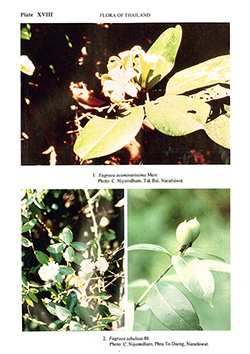e-Flora of Thailand
Volume 6 > Part 3 > Year 1997 > Page 201 > Loganiaceae > Fagraea
3. Fagraea ceilanica Thunb.wfo-0000685540
Vet. Acad. Handl. Stockh. 3: 132. 1782; Clarke in Fl. Br. Ind. 4: 83. 1883; Leenhouts in Fl. Males., Ser. 1, Spermat. 6: 315. 1962; Tirel-Roudet in Fl. C.L.V. 13: 53. 1972; Hô, Câyco Vietnam 2: 846. Fig. 6063. 1992. Plate XVII: 2.
Accepted Name : This is currently accepted.
Synonyms & Citations :
Description : Liane, shrub or tree to 20 m, bark greyish, not fissured, slash-mark white; twigs grey, subterete. Leaves petiole 1–3.5 cm; lamina very variable in shape, usually (oblanceolate-) narrowly obovate to obovate, also elliptic or oblong, rarely ovate, 3.5–25 by 1.8–11.5 cm; base cuneate; apex rounded to acute, acuminate; coriaceous; midrib flat or barely raised above, prominently rounded to keeled below, secondary veins 4–7 pairs, barely visible to invisible above and below. Stipules 1–2 mm high in leaf axils. Inflorescence terminal, to 10 cm, 3–9(–12)-flowered, lax to dense; peduncle 0–5 cm; pedicels 0.8–4.5 cm. Calyx 0.9–2.7 cm high, campanulate to barely urceolate; lobes 5–12 mm, rounded to oblong. Corolla 4.2–8 cm, white to pale yellow; tube 3.3–4.5 mm, wide to narrowly funnel-shaped; lobes 1.8–3.5 cm, narrowly obovate to oblong. Stamens exserted, but not beyond corolla lobes, filaments 2.2–3.5 cm; anthers 6–10 mm, narrowly oblong to ovate. Ovary and style 4–6 cm; stigma 1.3–4 mm, obconical to peltate. Fruit green with a thin translucent coat covering a sticky layer, to 4.5 cm diam., globose. Seeds 2.5–3 mm, oblong-ellipsoid to ovoid.
Thailand : NORTHERN: Chiang Mai, Chiang Rai, Lamphum (Doi Din Daeng), Lampang, Phrae, Phitsanulok; NORTH-EASTERN: Phetchabun, Loei, Sakon Nakhon; EASTERN: Chaiyaphum, Nakhon Ratchasima, Buri Ram, Surin; SOUTH-WESTERN: Kanchanaburi; CENTRAL: Krung Thep Maha Nakhon (Bangkok); SOUTH-EASTERN: Chanthaburi, Trat; PENINSULAR: Ranong (Bang Bon), Surat Thani, Nakhon Si Thammarat, Satun, Yala (Khao Kalakhiri), Narathiwat.
Distribution : India, Sri Lanka (type), Burma, Laos, Vietnam, S China, Malesia.
Ecology : Usually epiphytic in evergreen, mixed deciduous or open limestone forests, often growing by streams, open rocky places, edges of peat-swamp forests.
Vernacular : Kongkang khao (โกงกางเขา)(Southeastern); nang sawan (นางสวรรค์), niu nang sawan (นิ้วนางสวรรค์), phoda (โพดา)(Peninsular); fa mue phi (ฝ่ามือผี)(Shan-Mae Hong Son); thian ruese (เทียนฤาษี)(Northern).
Uses: Occasionally cultivated as an ornamental.
Notes: A highly variable species throughout its range but not sub-divided here as clear delimitation of taxa is not possible.

